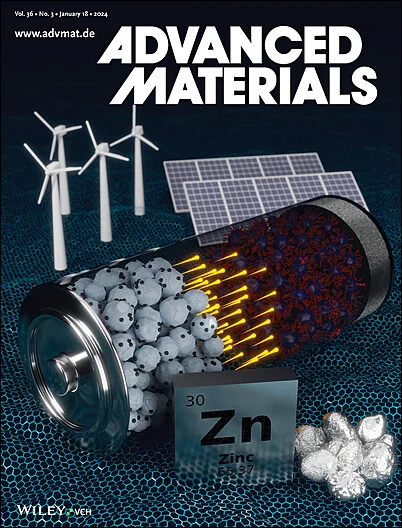Surface-Engineered Orthopedic Implant to Break the Antimicrobial-Osteogenic Paradox at Biointerfaces in the "Race for the Surface".
IF 26.8
1区 材料科学
Q1 CHEMISTRY, MULTIDISCIPLINARY
引用次数: 0
Abstract
Implant-associated infections and compromised osseointegration pose a dual threat to bone implants due to the biological conflict between microbial invasion and host cell colonization. However, conventional contact-killing antimicrobial coatings may negatively affect the viability of mammalian cells, limiting their further application. Here, a surface modification strategy is proposed to help mammalian cells to win the "race for the surface" on the material-tissue interfaces. Through polyphenol-amine-mediated covalent modification, quaternary ammonium groups (bactericidal agents) and phosphate groups (promoting bone-regeneration factors) are spatially organized on titanium (Ti) surfaces to regulate the surface chemical characteristics of dental implants. The surface-engineered implants (Ti-AQs) exhibited balanced antibacterial and biocompatible properties. The optimized Ti-AQ-2 coating eradicated >99% of Staphylococcus aureus (S. aureus) and Escherichia coli (E. coli) via destruction of disrupted bacterial membranes through metabolic interference, and simultaneously promoted adhesion, proliferation and osteogenic differentiation of bone marrow mesenchymal stem cells through Ca2+-mediated signaling pathways. Moreover, Ti-AQs can drive immunomodulation biased macrophages toward pro-repair M2 polarization. In vivo evaluations in an implant-associated infection modal confirmed that Ti-AQ-2 inhibited infection at the early stage and enhanced bone-implant integration at the late stage. This work presents a facile strategy to regulate the surface performances for developing of antibacterial implants with high biocompatibility and bioactivity.表面工程骨科植入物打破“表面竞赛”中生物界面的抗菌-成骨悖论。
由于微生物入侵和宿主细胞定植之间的生物学冲突,种植体相关感染和骨整合受损对骨种植体构成双重威胁。然而,传统的接触杀伤抗菌涂层可能会对哺乳动物细胞的活力产生负面影响,限制了它们的进一步应用。本文提出了一种表面修饰策略,以帮助哺乳动物细胞在材料-组织界面上赢得“表面竞赛”。通过多酚胺介导的共价修饰,季铵基(杀菌剂)和磷酸基(促进骨再生因子)在钛(Ti)表面进行空间组织,调节种植体的表面化学特性。表面工程植入物(Ti-AQs)具有平衡的抗菌和生物相容性。优化后的Ti-AQ-2包被通过代谢干扰破坏被破坏的细菌膜,根除了bbb99 %的金黄色葡萄球菌(S. aureus)和大肠杆菌(E. coli),同时通过Ca2+介导的信号通路促进骨髓间充质干细胞的粘附、增殖和成骨分化。此外,Ti-AQs可以驱动免疫调节偏倚的巨噬细胞向促修复的M2极化方向发展。在植入物相关感染模型中的体内评估证实,ti - aq2在早期抑制感染,并在后期增强骨-植入物的整合。本研究为开发具有高生物相容性和生物活性的抗菌植入物提供了一种简单的调节表面性能的策略。
本文章由计算机程序翻译,如有差异,请以英文原文为准。
求助全文
约1分钟内获得全文
求助全文
来源期刊

Advanced Materials
工程技术-材料科学:综合
CiteScore
43.00
自引率
4.10%
发文量
2182
审稿时长
2 months
期刊介绍:
Advanced Materials, one of the world's most prestigious journals and the foundation of the Advanced portfolio, is the home of choice for best-in-class materials science for more than 30 years. Following this fast-growing and interdisciplinary field, we are considering and publishing the most important discoveries on any and all materials from materials scientists, chemists, physicists, engineers as well as health and life scientists and bringing you the latest results and trends in modern materials-related research every week.
 求助内容:
求助内容: 应助结果提醒方式:
应助结果提醒方式:


